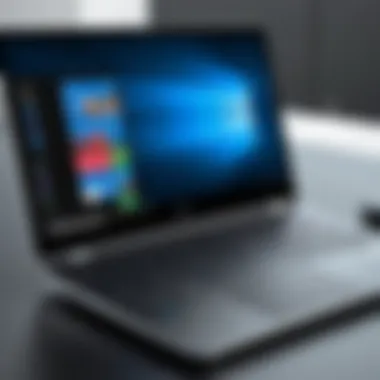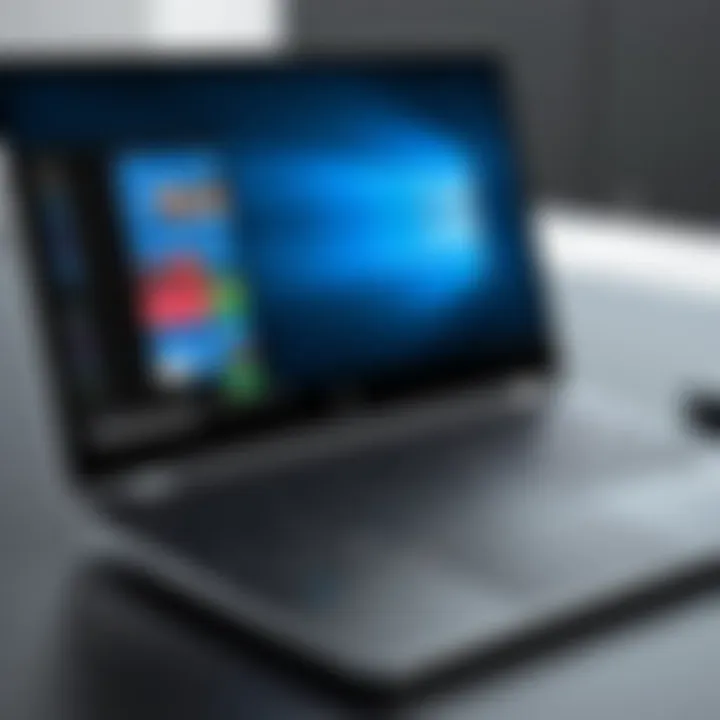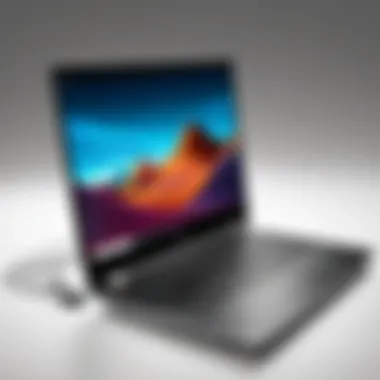Enhance Your HP Laptop Performance on Windows 10


Intro
In an age where technology underpins nearly every aspect of our lives, ensuring optimal performance of our devices is paramount. For users of HP laptops running Windows 10, this means understanding a myriad of strategies to get the most out of their machines. From tweaking system settings to considering hardware upgrades, each step is essential to enhance speed and responsiveness. This guide aims to dissect the labyrinth of optimization strategies, serving both the casual user and the tech-savvy enthusiast with practical advice embedded in a coherent narrative.
Overview of Cyber Security Threats
In the quest for enhancing laptop performance, the lurking shadows of cyber security threats cannot be ignored. These threats, if overlooked, can hamper not just the user experience but also lead to severe consequences like data theft and system breaches. Understanding the types of cyber threats is the first step in safeguarding your device while you embark on optimizing its performance.
Types of Cyber Threats
- Malware: This umbrella term includes several malicious software types such as viruses, worms, and Trojan horses, all aimed at compromising computer security.
- Phishing: A deceptive tactic often used in emails that trick users into divulging personal information by masquerading as a trustworthy source.
- Ransomware: A growing concern where your files are held hostage until a ransom is paid, rendering your system virtually useless.
Statistics on Cyber Attacks
According to recent studies, there is a cyber attack every 39 seconds, which translates to about 2,244 times a day. The alarming figures paint a clear picture—if you're not taking precautions, you're standing on shaky ground.
Real-life Examples of Security Breaches
Several high-profile breaches have sent ripples through the tech world. For instance, the Equifax data breach exposed sensitive information of approximately 147 million users, showcasing the potential fallout from inadequate security measures. These instances underline the pressing need for users to be proactive.
Best Practices for Online Security
When optimizing your HP laptop, it's crucial to ensure that security measures are embedded into the optimization process. Here are some best practices for maintaining not just performance but safety as well:
- Strong Password Creation: Craft complex passwords using a mix of letters, numbers, and symbols. Consider using phrases that are easy for you to remember but tough for others.
- Regular Software Updates: Keeping your operating system and applications up to date is vital. These updates often contain security patches that protect your machine from vulnerabilities.
- Two-factor Authentication: Adding an extra layer of security is always beneficial. This can be achieved by linking your account to a mobile device for confirmation steps during login.
Reviews of Security Tools
The right tools can fortify your HP laptop’s defenses against threats. Below are some evaluations of popular security tools:
- Antivirus Software Effectiveness: Tools like Norton and Bitdefender offer robust protection; however, their effectiveness can depend on how regularly the software is updated and configured.
- Comparison of Firewall Protection: Windows Defender provides solid baseline protection, but for users seeking more control, third-party options like ZoneAlarm can be useful.
- Assessment of Password Managers: Tools like LastPass and Dashlane streamline your password management while also enhancing security by generating strong, unique passwords for all accounts.
Tips for Ensuring Online Privacy
While securing your HP laptop, privacy should be a concurrent focus. Here are strategic tips:
- Using VPNs: A Virtual Private Network encrypts your internet connection, making it more difficult for cybercriminals to access your data and providing a secure browsing experience.
- Privacy Settings on Social Media: Regularly review the privacy settings on platforms like Facebook to manage who can view your posts and personal information effectively.
- Protecting Personal Data: Be cautious when inputting sensitive information online, especially in transactions, and always verify the legitimacy of a website before entering details.
Educational Resources and Guides
For those looking to further deepen their knowledge of cyber security, a wealth of resources is available:
- Encryption Tools: Detailed how-to articles can guide you through setting up tools such as VeraCrypt to secure your files.
- Spotting Phishing Emails: Step-by-step guides are invaluable; recognizing red flags in emails can prevent potential data breaches.
- Cheat Sheets for Quick Security Enhancements: Handy references can serve as quick reminders of best practices to enhance your online security.
As you delve deeper into optimizing your HP laptop, remember that maintaining excellent performance goes hand in hand with ensuring it's secured against threats. By following the strategies highlighted here, you can create a balanced approach to both functionality and safety.
Understanding Performance Bottlenecks
In the realm of optimizing an HP laptop running Windows 10, understanding performance bottlenecks serves as the bedrock for any enhancement efforts. A performance bottleneck occurs when a certain component of your laptop is underperforming, thus creating a hurdle for the overall functioning of the device. Recognizing these roadblocks can save time and frustration, enabling a smoother and more responsive computing experience.
Key Benefits:
Addressing bottlenecks not only boosts speed but also maximizes the lifespan of your laptop. By identifying issues early on, users can prevent gradual performance decline that often leads to costly repairs or replacements. It opens up a pathway to more tailored upgrades, ensuring you spend resources effectively.
Considerations:
Hardware issues, software conflicts, or even misconfigured settings can all contribute to performance problems. It's essential to take a holistic view when troubleshooting. For example, an aging hard drive may slow down startup times, while excessive background processes might hog resources, hindering app responsiveness. Understanding how these various elements interplay will give users an upper hand in optimizing their systems successfully.
Identifying Slow Startup Issues
One of the first signs of a struggling laptop is a prolonged startup time. This can be caused by myriad factors including outdated software, excessive startup programs, or failing hardware. By identifying the causes of slow startups early, users can implement changes that significantly speed up their experience.
Analyzing Resource Usage
Using Task Manager
Task Manager is like the pulse of your laptop, providing insights into what is consuming system resources at any given moment. Its intuitive interface allows you to examine real-time usage while offering a birds-eye view of application performance. Notably, Task Manager stands out due to its ease of access; simply right-click the taskbar and select "Task Manager" to launch it. In this article, it serves a pivotal role in diagnosing performance issues. With features such as CPU, memory, disk, and network utilization rates, it gives users clarity on whether software or hardware is holding their system back. The downside is that it can be overwhelming for those not familiar with technical jargon, but with a little practice, it becomes a handy tool.
Understanding CPU and Memory Usage
When discussing performance bottlenecks, understanding CPU and memory usage is integral. The CPU, or Central Processing Unit, can be seen as the brain of your laptop, processing tasks and applications. If it's constantly maxed out, everything from word processing to video streaming can lag significantly. On the other hand, memory (RAM) serves as short-term storage where data is temporarily held for quick access. An overextended memory can lead to even the simplest tasks becoming a slog.
Why Understanding It Matters:
Being attuned to how much CPU and memory are being used can directly inform your next steps in optimization. For instance, if you discover that certain applications are disproportionally consuming resources, it may be time to consider alternatives or updates.
Unique Features:
In Task Manager, you can even track the history of resource usage, which helps in spotting patterns over time. However, the challenge lies in interpreting this data quickly and accurately, especially for those who aren't tech-savvy.
Recognizing Software Conflicts
Software conflicts often surface when applications try to utilize the same resources simultaneously or when there are compatibility issues between different programs. Sometimes, even trendy or powerful software can be culprits. For example, having multiple antivirus programs can slow down processes significantly due to conflict in scanning and resource allocation. It's imperative to regularly evaluate the software running on your laptop, ensuring they coexist smoothly.


By understanding these nuances related to performance bottlenecks, users can pinpoint where issues arise and take informed actions to mitigate them, setting the stage for enhanced system efficiency.
System Settings Optimization
Optimizing system settings on your HP laptop running Windows 10 is a vital step toward achieving enhanced performance and responsiveness. Many users may not realize that adjustments in system settings can lead to significant boosts in speed and efficiency. This section delves into various ways to refine your laptop’s configuration, focusing on power settings, startup program management, and visual effects. By tweaking these settings, users can tailor their experience and potentially overcome hindrances that lead to a sluggish system.
Adjusting Power Settings
Choosing High Performance Mode
Selecting High Performance Mode is akin to giving your laptop a shot of espresso. This mode ensures that all hardware resources are dedicated to performance instead of conserving energy. It’s particularly useful during intensive tasks, such as gaming or video editing, where every ounce of processing power is necessary.
- Key Characteristic: High Performance Mode keeps the CPU running at its highest potential, preventing it from throttling down when less power is needed.
- Benefits: By utilizing this mode, users often notice a marked difference in responsiveness and speed, making it a favored choice among gamers and professionals alike. The downside might be higher power consumption, which is not ideal for battery life, especially for those on the go.
Customizing Power Plans
Customizing Power Plans allows users to develop a tailored experience based on their personal preferences and usage patterns. This feature grants the flexibility to juggle between performance and energy consumption, making it an essential tool for managing overall laptop efficiency.
- Key Characteristic: Each power plan can be adjusted to alter features like display brightness, sleep settings, and processor power management.
- Benefits: Users can create a power plan that suits their needs. For example, a customized plan for battery preservation might reduce CPU performance during lighter tasks, maximizing battery life without sacrificing user experience. However, those adjustments may not yield the same responsiveness during high-demand activities.
Disabling Startup Programs
Disabling unnecessary startup programs can drastically cut down boot time and free up system resources immediately after logging in. Many applications often set themselves to launch at startup, but most users rarely utilize all of them. By streamlining the startup process, an HP laptop can transition from shutdown to usability more quickly, avoiding the dreaded spinning wheel of waiting.
Configuring Visual Effects
Adjusting for Best Performance
Adjusting settings for Best Performance essentially prioritizes speed over aesthetics. This method turns off many visual frills—like shadows and animations—that can drain resources. For users attempting to squeeze out every bit of performance, especially when dealing with older hardware, this setting can be a game changer.
- Key Characteristic: When configured for best performance, Windows will alter several graphical settings to minimize resource consumption.
- Benefits: Users will find that their system speeds improve noticeably, allowing for smoother operation of demanding programs. On the flip side, the visual experience becomes stark and less engaging.
Managing Windows Animations
While some enjoy the flair of Windows animations, managing or reducing them can enhance the fluidity of system performance. Disabling or streamlining these animations can lead to quicker navigational responses, particularly on lower-end HP laptop models.
- Key Characteristic: Animations are small but can be resource-heavy, affecting overall performance.
- Benefits: Simplifying or eliminating these animations can lead to a more responsive system feel, though it may sacrifice some visual appeal in the process.
Consider this: Finding the right balance between aesthetics and performance is crucial. Users should weigh their needs against the advantages and disadvantages of each optimization.
In summary, optimizing system settings is a nuanced but rewarding task. Users can leverage power settings, manage startup programs, and adjust visual effects to unlock enhanced performance from their HP laptops on Windows 10.
Hardware Enhancements
When it comes to breathing new life into your HP laptop running Windows 10, hardware enhancements present a critical avenue of exploration. While software settings often receive a fair share of attention, hardware upgrades can unlock the true potential of your machine, ultimately leading to a smoother, more efficient user experience. Focusing on the right enhancements can quite literally change the game for performance, especially for those who rely heavily on their devices for work or leisure. Alongside improving speed, the benefits of hardware enhancements commonly include better multitasking capabilities, longer device lifespan, and even network performance.
Choosing to delve into this section is essentially about evaluating where your laptop stands today and envisioning how, with some thoughtful upgrades, it could operate tomorrow.
Upgrading RAM
Benefits of Increased Memory
Upgrading RAM is akin to giving your laptop a hearty meal; it provides the necessary fuel for optimal performance. More memory allows your system to handle multiple applications running simultaneously without chugging along like a rusty old train. One significant advantage of increased memory is enhanced multitasking—for example, consider a scenario where you're streaming a video, drafting a report, and running a virus scan all at once. Without sufficient RAM, you might experience slowdowns or crashes, akin to trying to juggle too many balls at once; one or more are bound to hit the ground.
Furthermore, upgrading RAM can delay the obsolescence of your device. As applications and operating systems evolve, they often become more resource-intensive. Thus, having an extra cushion of memory can help your laptop keep pace with current software demands, ensuring it doesn't become a dinosaur in a tech-savvy world.
How to Choose Compatible RAM
Selecting the right RAM for your HP laptop is not just about picking any module off the shelf—compatibility is key. The specific characteristics you need to watch for include the RAM type (like DDR4), the size (4GB, 8GB, etc.), and the speed measured in MHz. Getting this right can be a difficult puzzle, as each laptop has its own quirks.
Easy installation is one of the major highlights of when you choose compatible RAM. Most HP laptops come with user manuals that detail compatible memory module specs, saving one from unnecessary frustration.
A unique feature of upgrading RAM lies in dual-channel memory configurations—which are used to harness power from two RAM sticks instead of one, effectively doubling the data paths. However, not all laptops support this setup, making the research aspect crucial.
Switching to SSD Storage
Making the switch to SSD storage can be a game-changer in the realm of hardware enhancements. Unlike traditional hard drives, SSDs use flash memory, which significantly reduces load times. For example, booting up your laptop or launching applications will feel like flipping a switch rather than cranking a handle. One of the standout features of SSDs is their durability; they are less prone to physical damage than conventional drives. For users who often transport their laptops, this can be a solid advantage.
Cleaning Internal Components
Removing Dust and Debris
Keeping the internal components of your laptop clean can be as valuable as upgrading your hardware itself. Over time, dust and debris accumulate inside the machine, creating a barrier that can impede airflow and trap heat. This buildup can lead to overheating, which may throttle performance or, worse yet, damage components. Regularly cleaning out this debris can bolster your laptop’s performance and extend its lifespan.
Moreover, investing a little time in good ventilation practices and avoiding dusty environments can make a noticeable difference in your laptop’s health over the long haul.


Applying Thermal Paste
Thermal paste is not the first thing that comes to mind in hardware discussion but can have a significant impact on performance. When you apply thermal paste between the CPU and the heatsink, it enhances heat transfer efficiency, keeping your machine running cooler and quieter. An effective thermal interface can prevent throttling during intensive tasks.
Choosing to apply thermal paste is best done during a cleaning or upgrade session, but it’s important to follow proper guidelines. Using a high-quality paste is requisite; lesser-quality compounds can lead to poor performance. Overall, managing heat effectively can prevent damage to internal components and enhance overall efficiency.
Software Maintenance
Maintaining the software on your HP laptop is crucial for keeping it running smoothly and efficiently. Software maintenance includes regular updates, scans for malware, and the removal of unnecessary programs, which altogether contribute to a more responsive and secure operating system. When software is ignored, it can become sluggish and vulnerable to various threats. The longer you let it go unchecked, the more problems you may face in terms of performance and security. Performing regular maintenance ensures that your laptop functions better and has a longer lifespan.
Updating Windows and Drivers
Importance of Regular Updates
Keeping your operating system and drivers up to snuff is pivotal for optimal performance. Regular updates fix bugs, patch security vulnerabilities, and improve functionality. A laptop that runs outdated software is like a car on its last leg; it might work but is likely to break down at any moment.
One significant aspect of regular updates is the improvement of security protocols. Cybersecurity threats are advancing daily, and without the latest patches, your laptop becomes an easy target for hackers. Updating your Windows and drivers equips your system with the necessary defenses.
The benefits of regular updates cannot be overstated. They not only enhance performance but they also help in preventing unauthorized access to your data.
How to Check for Updates
Checking for updates isn’t rocket science; it’s quite straightforward. You can go to the settings and find the update section. Windows provides a simple check option that searches for pending updates in no time. This aspect makes checking for updates an easy and efficient process—the sort of thing you can do while waiting for your morning coffee to brew.
A unique feature of checking for updates in Windows is that it can automatically install important updates without much hassle. However, if you don't set it up to do this, you might forget and miss crucial patches. Knowing how to check for updates keeps your system current and safe, preventing long-term problems.
Malware and Antivirus Scans
Choosing the Right Antivirus Software
Selecting an antivirus is akin to finding a trustworthy guardian for your digital life. The right antivirus software provides a solid line of defense against malware and other malicious attacks. Many users often overlook this, thinking their laptop is safe without one. However, in today’s cyber world, this is like leaving your front door wide open.
A key characteristic of choosing the right antivirus is its ability to offer real-time protection. This means monitoring your system consistently, rather than just running occasional checks. A good antivirus program will also have frequent definition updates, ensuring it can recognize the latest threats. This keeps your machine in tip-top shape.
Regular Scanning Practices
Establishing a practice of regularly scanning your laptop is essential in detecting any lurking issues before they escalate into major problems. Frequent scans help in identifying potential threats and vulnerabilities in your system, acting as a precautionary measure. It’s much like a check-up at the doctor; you don’t want to wait until something serious arises to take action.
The beauty of regular scanning is that many antivirus programs allow you to schedule scans at your convenience. This ensures the scans happen without your intervention, giving you peace of mind. The downside? If you neglect to set up the frequency, you might end up missing crucial threats that could slow down your laptop.
Uninstalling Unused Programs
Taking the time to uninstall programs you no longer use is a simple yet effective step in maintaining your laptop’s performance. Every software you install affects the resources and overall speed of your device, and unused programs can hog precious storage space and processing power.
Uninstalling apps that are gathering digital dust can free up memory and make your system run faster. This is especially true for applications that load during startup, as they can significantly slow down your boot time. A little spring cleaning now and then does wonders for your device.
In short, software maintenance is not just a nice-to-have; it is a must-have strategy for anyone looking to keep their HP laptop running smoothly. Regular updates, diligent antivirus protection, routine scanning, and cleaning out unused applications are practical steps you can take toward ensuring your device remains secure and efficient.
Ultimately, implementing these practices will lead to a noticeable improvement in overall performance and security.
Optimizing Network Performance
Optimizing network performance is crucial for any user who relies on their HP laptop to connect with the world, whether for work or leisure. A sluggish connection can turn a simple task into a frustrating ordeal. By fine-tuning your network settings, you can enhance your online experience, ensure quicker downloads, smoother streaming, and reduce lag during online gaming. In this part, we will delve into the aspects you can tweak to bring your networking up a notch, covering two key areas: managing your Wi-Fi settings and leveraging Ethernet connections effectively.
Managing Wi-Fi Settings
Managing your Wi-Fi settings can drastically influence how well your HP laptop interacts with the internet. Here are a few pointers on what to examine:
- Changing the Wi-Fi Channel: Sometimes, interference from nearby routers can throw your connectivity a curveball. Access your router settings through a web browser and experiment with different channels. You might discover a less congested path that smooths out your connection.
- Adjusting Bandwidth Settings: Many routers nowadays have dual-band capabilities. If your laptop supports it, switch to the 5 GHz band. This band tends to be less crowded and can provide faster data rates, especially in spaces with multiple networks.
- Optimizing Security Settings: Ensure that your Wi-Fi network is secured with a strong password to deter unauthorized access. Using WPA3 encryption is the gold standard. This not only enhances security but also ensures that bandwidth is not wasted on unauthorized users.
Regularly checking and updating firmware on your Wi-Fi router plays a pivotal role, too. Bugs in the software can often lead to performance hiccups. If you’re unsure how to access the router, a quick internet search with the model number can guide you to the manufacturer's instructions.
"A strong Wi-Fi signal is like having a clear road; less traffic means faster travel."
Utilizing Ethernet Connections
Though Wi-Fi provides a level of convenience, don’t underestimate the power of a wired connection. Here are some key advantages of utilizing Ethernet:
- Consistency and Stability: Ethernet connections typically offer more stability compared to Wi-Fi. If you do any work that is sensitive to interruptions – think video conferencing or online gaming – opting for an Ethernet connection can provide a more dependable experience.
- Increased Speed: Wired connections can often deliver faster speeds, not to mention lower latency. This means less lag, which is desirable for tasks demanding speed and precision.
- Security Benefits: With a direct connection, you're less susceptible to certain types of cyber threats that can plague wireless networks. This is an essential consideration for anyone who is concerned about online security and privacy.
To connect via Ethernet, make sure you have a compatible cable and find an open port on your router. Plugging in should be straightforward – it’s simply a matter of ensuring both ends are securely connected.
In summary, optimizing network performance can elevate your HP laptop’s capabilities, making it a tool that works as hard as you do. Whether managing Wi-Fi settings or utilizing Ethernet, these adjustments are essential for maintaining an efficient online experience.
Utilizing Built-in Windows Tools


When it comes to maximizing the performance of your HP laptop running Windows 10, utilizing built-in Windows tools is akin to having Swiss Army knife at your disposal. These tools are not just there for decoration; they provide functionality that can help maintain system health, diagnose problems, and optimize your overall experience. Leveraging these features can lead to a noticeable difference in how your laptop runs, allowing you to tackle everything from bloatware to system slowdowns effectively.
Running Disk Cleanup
One of the understated champions in Windows 10 is the Disk Cleanup tool. This handy feature is designed to free up space on your hard drive, which can improve speed and efficiency. As time progresses, it's easy for accumulated files like temporary files and system caches to turn your once sprightly laptop into a sluggish beast. Regularly running Disk Cleanup can be a straightforward solution to manage your storage better and enhance system performance.
To access Disk Cleanup, you can type in the Start menu search bar. The tool will prompt you to choose the drive you wish to clean. Typically, the C: drive is selected, as it hosts the operating system. You can then check the boxes beside the types of files you want to delete, such as:
- Temporary Internet Files – Extra space for browsing
- Recycle Bin – Purging deleted files
- Temporary Files – Those nagging leftovers
- System files – Older Windows updates that are no longer necessary
"Regular cleanup means a faster laptop. If you want your HP to run like the wind, don’t skip this step!"
After clicking OK, the numbers will surprise you sometimes. You might reclaim several gigabytes of space. This not only helps in speeding up the system but also improves load times for applications. Furthermore, keeping your disk space at a reasonable level allows necessary updates and new applications ample room to function.
Using Performance Troubleshooter
Another gem in the Windows toolbox is the Performance Troubleshooter. If you've noticed your HP laptop creeping like a snail, this tool can be your first line of defense. Instead of playing a guessing game, the troubleshooter conducts an assessment of various performance issues and suggests pertinent fixes.
You can find the Performance Troubleshooter by searching in the Start menu or directly navigating through Settings > Update & Security > Troubleshoot > Additional troubleshooters. From the list, select , and follow the prompts.
This tool checks for:
- Resource-heavy applications – in case you are running too much at once
- Background programs – unnecessary ones that might be hogging resources
- Battery settings – particularly if your HP laptop is running in power-saving mode
After the diagnostics are completed, the tool may recommend adjustments. This could mean disabling some startup programs or changing the power settings for better performance. Ignoring these suggestions could mean missing out on a quicker, more responsive system.
In short, using these built-in tools can make a significant impact on your device’s performance. They require little effort but pack a punch when it comes to enhancing efficiency and ensuring that your HP laptop continues to work smoothly. So, consider them essential allies in your quest for optimal performance.
Regular Maintenance Routines
In the realm of computing, regular maintenance routines serve as the lifeblood of optimal performance, particularly for HP laptops running Windows 10. Just like a car requires periodic oil changes and check-ups to run smoothly, your laptop demands attention and care to ensure its longevity and effectiveness. These routines aren't just for keeping the machine running; they're essential for preserving data integrity, improving efficiency, and reducing security vulnerabilities.
One of the most pivotal aspects of these routines is the establishment of backup protocols. Loss of files can feel like a heavy weight on one’s shoulders, especially if they contain vital information. Regular backups can help mitigate the agony of data loss, be it due to hardware failures, accidental deletions, or even malicious attacks. The goal here is to create a reliable process through which files are regularly saved and made accessible, helping to ensure that important information remains recoverable.
Benefits of having a solid backup plan include:*
- Peace of Mind: Knowing your data is safe allows you to focus on using your laptop rather than worrying about what might happen.
- Data Recovery: In the unfortunate event of a crash, having backups means you can restore your systems with minimal hassle.
- Version Control: Backups can often help retrieve older versions of files, which can be crucial for projects that evolve over time.
To get started with establishing backup protocols, consider using options like Windows File History or third-party solutions such as Dropbox or Google Drive. Make it a habit to set these backups on a schedule—weekly, bi-weekly, or monthly—depending on your usage patterns. Automating the process can further minimize the chance of forgetting this important task.
Regular backups are not just a recommendation; they're a necessity for data protection.
Establishing Backup Protocols
When diving into the specifics of backup protocols, start by assessing what needs to be backed up. Common elements include:
- Documents: Projects, reports, and personal files are crucial.
- Photos and Videos: Many people keep precious memories on their machines, so these should be prioritized.
- Application Data: Certain applications store vital data that should be protected—this is especially true for design software or coding environments.
Once you’ve identified what to back up, select a method. Whether it’s external hard drives, cloud storage solutions, or both, having redundancies can serve as an additional safety net. Regularly verify that backups are completing as intended. After all, without regular checks, one might find out too late that the backups are corrupted or incomplete.
Routine System Checks
Routine system checks can often seem like a mundane aspect of laptop maintenance, yet they provide a foundational layer of performance optimization. Checking system performance and errors helps catch small issues before they burgeon into major problems. You'll want to regularly monitor several aspects of your HP laptop’s functionality:
- Disk Space: Keep an eye on how much storage is in use. Windows will start slowing down when your laptop is nearly at full capacity. Aim to keep at least 15-20% of your disk space free.
- Update Status: Regularly checking for updates ensures that your operating system and drivers are current. This not only improves security but also enhances compatibility with software.
- Malware Scans: Even individuals careful with their online habits can fall victim to malware. By conducting routine scans with reputable antivirus software, you can help to maintain a safe environment.
- Performance Metrics: Utilization of Task Manager helps to track CPU and memory usage. Are there unexpected processes hogging resources? Addressing these anomalies promptly can lead to smoother operation.
Developing this rhythm of routine checks can quietly but significantly enhance your HP laptop experience, allowing it to perform well over its useful life. Whether it’s a singular focus each week or setting reminders to perform broad checks, the end goal is improved performance and peace of mind.
Understanding Performance Limits
Every laptop, including your HP one, operates within a set performance boundary. Knowing these limits is crucial for several reasons. First, it helps you set realistic expectations. You might think that a simple upgrade can turn your aging device into a speed demon. However, that’s often not the case. Understanding how age, technology, and specifications all interplay can save you time and heartache.
Understanding performance limits also assists in prioritizing enhancements. When you have a clear picture of where your laptop stands, you can allocate resources—whether it’s time, money, or effort—more effectively.
Lastly, recognizing these constraints can guide you through troubleshooting problems. When issues arise, knowing whether they stem from age or hardware limitations can lead you to more targeted solutions.
Recognizing Laptop Age and Efficiency
Your HP laptop's age is more than just a number. It holds the key to its performance efficiency. Newer laptops generally come equipped with the latest technology, offering better processors, faster RAM options, and efficient energy consumption. If your laptop is a relic of three or four years ago, it may be clinging to older technology that can't keep up with today's demands. This might lead to sluggish operations, longer boot times, and frustratingly slow application launches.
You can assess your laptop’s efficiency through performance benchmarks that compare its specifications against current models. If your device is lagging behind significantly, it might be time to reassess your expectations and consider an upgrade.
"Age can be a great teacher, but it can be a terrible performance enhancer."
Determining When to Upgrade
Deciding when to upgrade hinges on a mix of observations and future plans. If your laptop struggles with simple tasks like web browsing or word processing, that’s a red flag. Running resource-hungry applications, like graphic design software or video editors, can exacerbate existing issues, too.
Here are some signs that point to upgrading being a good option:
- Frequent freezing or crashing while running multiple applications
- Prolonged boot-up times, taking several minutes to start
- Inability to run essential software updates due to hardware limitations
Upgrading doesn’t always mean purchasing a new machine, though. Sometimes, a simple memory increase or switching to a solid-state drive (SSD) can breathe new life into your laptop. Look closely at what you need. If your current model is outdated beyond repair, then investing in a newer model might just be your best bet.







